Why is my INVT iMars BG6KTR Inverter showing AC overfrequency?
- KKerri WhiteSep 10, 2025
An AC overfrequency error with your INVT Inverter is due to high frequency from the public grid.
Why is my INVT iMars BG6KTR Inverter showing AC overfrequency?
An AC overfrequency error with your INVT Inverter is due to high frequency from the public grid.
Why is my INVT iMars BG6KTR Inverter showing AC overvoltage?
AC overvoltage in your INVT Inverter is due to high voltage from the public grid.
Why is my INVT iMars BG6KTR Inverter showing AC undervoltage?
AC undervoltage in your INVT Inverter is caused by low voltage from the public grid.
What causes input overvoltage in INVT iMars BG6KTR Inverter?
Input overvoltage in your INVT Inverter is due to DC input overvoltage.
What does output short-circuit mean on my INVT Inverter?
Output short-circuit on your INVT Inverter means there is a short-circuit at the output.
What causes input overcurrent in my INVT iMars BG6KTR Inverter?
Input overcurrent in your INVT Inverter is due to DC input overcurrent.
What does manual shutdown mean on my INVT iMars BG6KTR?
A manual shutdown on your INVT Inverter means the device was stopped by the operation panel or upper PC.
Why is my INVT Inverter showing AC underfrequency?
An AC underfrequency error on your INVT Inverter is due to low frequency from the public grid.
What does manual shutdown mean for INVT Inverter?
Manual shutdown of your INVT Inverter means it was stopped by the operation panel or upper PC.
What does data consistency fault mean for INVT Inverter?
A data consistency fault in your INVT Inverter indicates inconsistent grid voltage, frequency, leakage current, or AC/DC injection.
Explains warning symbols used for safety guidance.
Provides essential safety rules for operation and installation.
Outlines procedures for receiving and installing the inverter safely.
Details safety guidelines for operating the inverter when connected to the grid.
Covers safety aspects of maintaining and inspecting the inverter.
Provides instructions for the proper disposal and recycling of the inverter.
Describes the components and function of a PV grid-tied system.
Details the physical layout and components of the inverter.
Explains the information present on the inverter's nameplate.
Lists available product models and their specifications.
Provides physical dimensions and weight details of the inverter.
Details the procedure for checking the inverter upon delivery and unpacking.
Pre-installation checks and preparation steps.
Specifies requirements for selecting an appropriate installation location.
Lists the necessary tools for installing the inverter.
Provides cable specifications for AC/DC connections.
Recommends micro breaker specifications for safe operation.
Details the physical mounting process of the inverter.
Step-by-step guide for physically mounting the inverter.
Covers the detailed procedures and safety for electrical connections.
Explains how to connect the solar PV strings to the inverter.
Details the process of connecting the inverter to the AC grid.
Lists checks required before starting the inverter's operation.
Step-by-step guide to start grid-connected operation.
Procedures for safely stopping the inverter operation.
Guidelines for routine maintenance and inspection of the inverter.
Details periodic maintenance tasks and their frequency.
Specific instructions for cleaning the inverter and its fan.
Explains the meaning and states of the inverter's LED indicators.
Describes the buttons and their functions on the inverter's operation panel.
Details the LCD screen interface and navigation.
Explains how to navigate and operate various functions via the panel.
How to view monitoring parameters on the LCD screen.
How to access and view historical data and fault records.
How to view statistical information like lifetime and daily stats.
How to access and modify various system parameters.
How to view system details like model, serial number, and software version.
How to review current and historical fault information.
How to control inverter functions like ON/OFF, restart, and clear records.
How to select the country for grid certification settings.
Explains the standard RS485 communication method.
Describes optional communication modes like Ethernet and WiFi.
Explains warning symbols used for safety guidance.
Provides essential safety rules for operation and installation.
Outlines procedures for receiving and installing the inverter safely.
Details safety guidelines for operating the inverter when connected to the grid.
Covers safety aspects of maintaining and inspecting the inverter.
Provides instructions for the proper disposal and recycling of the inverter.
Describes the components and function of a PV grid-tied system.
Details the physical layout and components of the inverter.
Explains the information present on the inverter's nameplate.
Lists available product models and their specifications.
Provides physical dimensions and weight details of the inverter.
Details the procedure for checking the inverter upon delivery and unpacking.
Pre-installation checks and preparation steps.
Specifies requirements for selecting an appropriate installation location.
Lists the necessary tools for installing the inverter.
Provides cable specifications for AC/DC connections.
Recommends micro breaker specifications for safe operation.
Details the physical mounting process of the inverter.
Step-by-step guide for physically mounting the inverter.
Covers the detailed procedures and safety for electrical connections.
Explains how to connect the solar PV strings to the inverter.
Details the process of connecting the inverter to the AC grid.
Lists checks required before starting the inverter's operation.
Step-by-step guide to start grid-connected operation.
Procedures for safely stopping the inverter operation.
Guidelines for routine maintenance and inspection of the inverter.
Details periodic maintenance tasks and their frequency.
Specific instructions for cleaning the inverter and its fan.
Explains the meaning and states of the inverter's LED indicators.
Describes the buttons and their functions on the inverter's operation panel.
Details the LCD screen interface and navigation.
Explains how to navigate and operate various functions via the panel.
How to view monitoring parameters on the LCD screen.
How to access and view historical data and fault records.
How to view statistical information like lifetime and daily stats.
How to access and modify various system parameters.
How to view system details like model, serial number, and software version.
How to review current and historical fault information.
How to control inverter functions like ON/OFF, restart, and clear records.
How to select the country for grid certification settings.
Explains the standard RS485 communication method.
Describes optional communication modes like Ethernet and WiFi.
| Model | iMars BG6KTR |
|---|---|
| Rated Power | 6000 W |
| Max. DC Input Power | 9000 W |
| Number of MPPTs | 2 |
| Max. Output Power | 6000 W |
| Nominal Output Voltage | 400 V |
| MPPT Efficiency | 99.9% |
| Protection Degree | IP65 |
| Weight | 28kg |
| Frequency | 50/60 Hz |
| Operating Temperature Range | -25°C to +60°C |
| Storage Temperature | -40°C to +70°C |
| Humidity | 0-100% |
| Protection Features | Overvoltage |
| Type | Three-phase inverter |











